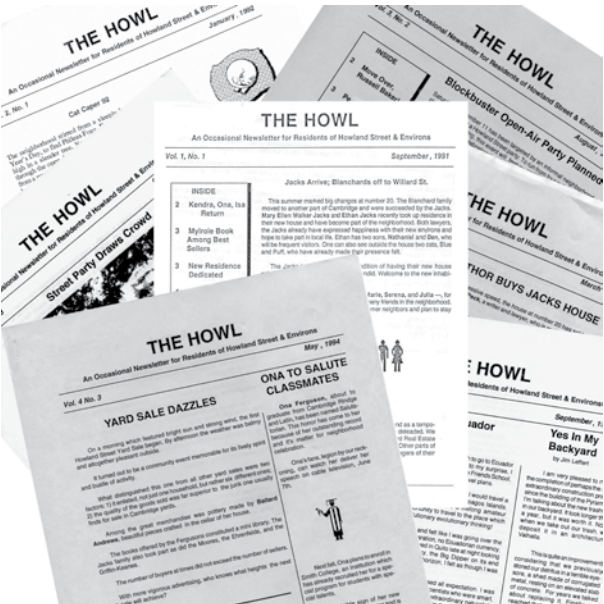The Howl
by Richard Griffin
The Howl was born in 1992 from a conversation held in midair over the Atlantic Ocean. My wife, Susan Keane, and I were returning from a vacation, and we were in the mood for a new project, preferably one that would benefit our neighborhood. We finally agreed that some kind of periodical could bring the people of Howland Street closer together. It would be an informal newsletter drawing on the talents of our neighbors but respectful of their privacy.
As it turned out, The Howl became a service that enabled members of our neighborhood to become more aware of one another. This benefit applies especially when new people move in. They can introduce themselves to readers or allow the editor to do it for them. Over time, neighbors have become essential contributors to The Howl. We invite them to share their news, their insights, and their creativity, and we especially treasure the contributions of children. They frequently have come up with fine poems and beautiful drawings that seem to grow in value as the years go by.

A look at The Howl over more than 20 years of publication shows much development. We who published it found new ways to make our pages informative. More residents found pleasure in contributing material. The humorists among us made the paper more enjoyable. So did the artists, poets, and raconteurs. It became easier to publish drawings and photographs. And we learned how to distribute The Howl across wider areas through email. Readers not living nearby, some of them on other continents, found ways of enjoying the publication.
Some contributions stand out –– for example, the one in which George Hein tells about his family’s exodus from fascist Italy. This story was accompanied by a picture of the ship that carried him as a young child to safety in the port of New York. And the fine photos of birds and other fauna submitted by Sherry Leffert are outstanding graphic art. I also enjoyed Bernd Widdig’s fine account of a bicycle trip from the top of Europe to the bottom, and, of course, I continue to value the holiday poem contributed by Susan Keane each December. She manages to include all Howland Street humans and most of their pets, trying to find rhyme and rhythm in their names. And photos of the area’s children in costume on Halloween night are a special treat each year.
We like to think that anyone interested in the recent history of the area covered by The Howl could find much material for study. They would see how a neighborhood changes as a city transforms itself.
The Cambridge Historical Society holds digital images of The Howl published between 1992-2014. To request access, please contact us at info@historycambridge.org
